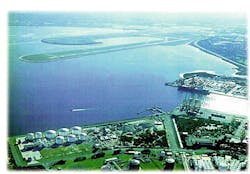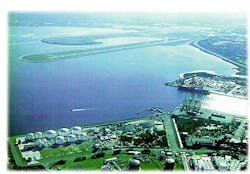Monitoring, safety systems for LNG and LPG operators
Warren R. True
Pipeline/Gas Processing Editor
Elgas Ltd.'s LPG storage terminal (bottom), Sydney, lies near the area's regional airport (top).Operators in Korea and Australia have chosen monitoring and control systems in recent contracts for LNG and LPG storage.
Korea Gas Corp. (Kogas) has hired Whessoe Varec, Calais, to provide monitoring systems for four LNG storage tanks being built at Kogas' Inchon terminal.
For Elgas Ltd., Port Botany, Australia, Whessoe Varec has already shipped a safety valve-shutdown system to a new LPG cavern-storage facility under construction.
Terminal monitoring
The terminal facilities being constructed at Inchon have been developed progressively over the last 8 years to handle the country's growing demand for LNG, following Kogas' ambitious plans for a nationwide natural-gas distribution system, unveiled in 1990 ( Fig. 1 [82,840 bytes]).The first six tanks of the eight-tank Terminal A project were built between 1990 and 1998 (Fig. 2 [126,381 bytes]). The final two tanks for Terminal A and the new Terminal B will provide landing and storage facilities for the increased diversification of LNG supply, which includes imports from Brunei, Australia, Malaysia, Indonesia and, starting in 1999, Qatar.
The sizes of the tanks have grown as the project has progressed, and the B phase of the Inchon project calls for extremely large tanks, says Whessoe Varec, with capacities of up to 200,000 kl.
The oversight systems at Inchon will provide Kogas with capabilities for monitoring stratification of LNG tank contents by using a new mobile level, temperature, and density gauge.
Dynamic approach
Whessoe Varec's new Model 1146 LTD gauge combines measurement of inventory with real-time views of temperature and density throughout the tank. Fig. 3 [96,384 bytes] presents a simplified plan of the LNG terminal at Inchon.With the ability to zoom-in and take as many as 250 readings over any tank segment, the gauge allows stratification to be closely observed and analyzed before it can build to critical levels, says Whessoe Varec.
This facilitates a dynamic approach to tank management, allowing Kogas to use its storage facilities cost-effectively, mixing multiple grades of LNG in the same tank and applying pumping to rehomogenize tank contents as required.
Whessoe Varec will supply measurement systems for two 120,000-cu m aboveground storage tanks being built for the existing Inchon A project and two 120,000-cu m vessels on the new Inchon B project-the first in a series of four very large storage tanks.
In addition to the new LTD gauges, Whessoe Varec is supplying a complete tank-monitoring system with multifunction sensors, roof-mounted servo tank gauges, and transmitters.
The instrumentation will be supplied via Daelim, the main project engineer, starting in March 1999.
This instrumentation will connect with a centralized Windows NT-based supervisory control and data acquisition (scada) system based on FuelsManager software from sister company Whessoe Coggins Systems.
Custom mimics and control facilities are being created in this package to help Kogas manage the tanks.
This open software package also can interface with other vendors' instruments to monitor data from other previously commissioned tanks, providing the operator with the means to upgrade in the future to a universal and networkable management system for the entire terminal.
Meeting demand
Whessoe Varec has shipped a safety valve-shutdown system to Elgas Ltd.'s LPG cavern storage facility under construction at Port Botany (Sydney), Australia. The system employs dual hydraulically operated valves that, in an emergency, shut down the casing end of the liquid-phase piping.Elgas, Australia's leading LPG distributor, decided to build this $100 million (Australian) cavern facility to meet the fast-growing demand for LPG, which must be imported by sea to meet the shortfall in local production.
Situated adjacent the major bulk liquids-handling terminal at Port Botany, the 65,000-metric ton cavern will allow LPG to be landed easily and cost-effectively via large bulk tankers. Once landed, the LPG will then be in the best location for low-cost transportation to the major markets throughout the densely populated East Coast.
The underground storage cavern, being built by Concrete Constructions will consist of four 230-m long galleries at a depth of approximately 130 m in the local solid sandstone (Fig. 4 [80737 bytes]). The pressure at this depth ensures hydrostatic containment.
Ships of up to 45,000-metric ton capacity will be able to discharge as much as 1,000-metric tons/hr of LPG into the cavern. Elgas says this high rate will be possible because of special new equipment developed recently for a Korean storage cavern. The company says it is only the second LPG cavern operator in the world to adopt this technology.
Elgas' aboveground facility was constructed under supervision of engineering contractor Kinhills.
The system will shut down on command from the plant's control/emergency shutdown (ESD) systems or from a command via the manual control panel, says Whessoe Varec.
It will also employ a further fail-safe mechanism of special plugs in the hydraulic lines that melt in the presence of fire, releasing the pressure that keeps the valves in their normally open position.
Whessoe Varec says its system protects seven gas intake/outtake pipes, using a valve system known as HOSV. The company has also supplied a remote control panel for the system, providing local instrumentation and manual operational facilities, plus an interface to the plant's ESD system.
The safety valve system is to be installed by Austral Engineering, Sydney, with commissioning set for mid-1999.
The plant will be managed by a Honeywell SCAN 3000 system, which provides process control and scada facilities on a scaleable PC-based platform, says Whessoe Varec. It is based on a client-server architecture and incorporates open systems technologies, including Windows NT, Ethernet, and TCP/IP.
In addition to controlling ESD for both the cavern and the site's tanker-loading station, the system controls all the other major process instrumentation. This includes the intrinsically safe temperature and pressure instruments inside the cavern, which are required accurately to control input, output, and inventory management.
Copyright 1998 Oil & Gas Journal. All Rights Reserved.

